I think we are all familiar with the medieval sword belts that are offset in their attachment to the scabbard. Because of the offset attachment, tightening the sword belt levers the scabbard out of the vertical position and into a more oblique position. Here is an example of an offset belt:
[ Linked Image ]
http://effigiesandbrasses.com/649/859/
After doing quite a bit of research, it seems that the offset belt did not appear until the middle of the 13th Century (c. AD 1250). Before that, swords were suspended more or less vertically from the sword belt. For example:
[ Linked Image ]
http://effigiesandbrasses.com/1170/1229/
Here is one of the earliest examples of the offset belt. The date is AD 1265.
[ Linked Image ]
http://effigiesandbrasses.com/1249/2965/
So.... I think we are doing it wrong when we make reproduction scabbards with offset belts that are supposed to represent periods before the mid-13th Century.
This means that all reproduction swords of Oakehott Type X, Xa, XI, XIa and early XII should not have an offset belt. This also includes all swords from the Norman period and the first 6 Crusades.
Comments?
Can you prove me wrong?
I took a look at the Maciejowski Bible and it appears that there is a variety of suspension methods used, though you do see a lot of repetition. Take a look here: http://www.manesse.de/BildSuche.php?id=358&am...a=erg&
I would say that people are not wrong using offset scabbard suspension methods, but straight-hanging swords were not uncommon. I would like to see more of these suspension methods represented, but I am personally attracted to the angled suspension methods. I'll just have to get a wider variety of swords and scabbards! :p
Thank you for bringing this up, as it made me take a more critical look at some source material, and I discovered that many swords are depicted as hanging straight.
I would say that people are not wrong using offset scabbard suspension methods, but straight-hanging swords were not uncommon. I would like to see more of these suspension methods represented, but I am personally attracted to the angled suspension methods. I'll just have to get a wider variety of swords and scabbards! :p
Thank you for bringing this up, as it made me take a more critical look at some source material, and I discovered that many swords are depicted as hanging straight.
Thank you Nathan for your reply. Your link was very informative, I would love to see more data like that. I am researching sword scabbards in detail and so far have cataloged detailed information on sword belts, scabbards and suspension methods for Oakeshott sword types X through XIIIa.
My data is organized by Oakeshott sword type and includes:
-sword belts (width, color, tooling, mounts, buckle types, fastening method, etc)
-scabbards (cover material, color, tooling, risers, rain guards, chapes, etc.)
-suspension methods (a wide array of vertical suspension methods, offset belts, rings & lockets, multiple straps, etc.)
The results of my research have reversed some of my own preconceived notions about how swords were carried in their scabbards, such as the offset belt.
The Mac Bible was written right about the time that the offset belt was developed (probably right before, actually). You have, no doubt, noticed that of all of the scabbards and suspension methods shown in your link, none have an offset belt.
I am saying that people are wrong using offset scabbard suspension methods for periods prior to c. AD 1250. That includes me. I just made an offset belt & scabbard for my 12th Century type XI sword - and now I have to try to salvage that work by replacing the belt with something more authentic. I may have to strip it down to the poplar core and start over.
In his 1891 article in the Journal of Archeology, The Sword Belts of the Middle Ages, Albert Hartshorne wrote of the vertical suspension method and the new offset beltt:
"Sir David de Esseby, from Castle Ashby, Northamptonshire, 1268, in polished Purbeck, gives us a new and important arrangement. Hitherto we have seen the belt attached solely to the top of the scabbard, the result being that the sword constantly hung in a more or less vertical position, and vibrated inconveniently. This was found to be an evil both on foot and on horseback. The new system of fastening the entire end of the buckle strap to the scabbards, and the other, or long strap, a few inches down the scabbard, had many advantages. It brought the grip of the sword more within the compass of the right hand, and the weight of the weapon, by leverage, tended to tighten and steady the belt, while, on horseback, the hilt was pitched outwards, and the sword thrown more into a line parallel with the side of the body on the horse and its rider."
My data is organized by Oakeshott sword type and includes:
-sword belts (width, color, tooling, mounts, buckle types, fastening method, etc)
-scabbards (cover material, color, tooling, risers, rain guards, chapes, etc.)
-suspension methods (a wide array of vertical suspension methods, offset belts, rings & lockets, multiple straps, etc.)
The results of my research have reversed some of my own preconceived notions about how swords were carried in their scabbards, such as the offset belt.
The Mac Bible was written right about the time that the offset belt was developed (probably right before, actually). You have, no doubt, noticed that of all of the scabbards and suspension methods shown in your link, none have an offset belt.
I am saying that people are wrong using offset scabbard suspension methods for periods prior to c. AD 1250. That includes me. I just made an offset belt & scabbard for my 12th Century type XI sword - and now I have to try to salvage that work by replacing the belt with something more authentic. I may have to strip it down to the poplar core and start over.
In his 1891 article in the Journal of Archeology, The Sword Belts of the Middle Ages, Albert Hartshorne wrote of the vertical suspension method and the new offset beltt:
"Sir David de Esseby, from Castle Ashby, Northamptonshire, 1268, in polished Purbeck, gives us a new and important arrangement. Hitherto we have seen the belt attached solely to the top of the scabbard, the result being that the sword constantly hung in a more or less vertical position, and vibrated inconveniently. This was found to be an evil both on foot and on horseback. The new system of fastening the entire end of the buckle strap to the scabbards, and the other, or long strap, a few inches down the scabbard, had many advantages. It brought the grip of the sword more within the compass of the right hand, and the weight of the weapon, by leverage, tended to tighten and steady the belt, while, on horseback, the hilt was pitched outwards, and the sword thrown more into a line parallel with the side of the body on the horse and its rider."
Last edited by Harry Marinakis on Thu 13 Feb, 2014 11:14 am; edited 1 time in total
Although the artist doesn't show the belts offset, the style of the straps on the scabbards in these two images seem to suggest that the belts should be offset.
http://manuscriptminiatures.com/3916/9853/
http://manuscriptminiatures.com/4185/12083/
This image seems to clearly show an offset belt.
http://manuscriptminiatures.com/4572/11745/
I'm also not sure about these two, are these offset?
http://effigiesandbrasses.com/783/1207/
http://effigiesandbrasses.com/1754/1750/[/img]
http://manuscriptminiatures.com/3916/9853/
http://manuscriptminiatures.com/4185/12083/
This image seems to clearly show an offset belt.
http://manuscriptminiatures.com/4572/11745/
I'm also not sure about these two, are these offset?
http://effigiesandbrasses.com/783/1207/
http://effigiesandbrasses.com/1754/1750/[/img]
Harry,
I thought Type XIII and XIIIa were generally dated to the second half of the 13th century into the early 14th c.? Perhaps the longer XIIIa required a canted suspension to keep the point up?
I agree with the Elisabethpsalter image.being offset, and a dating of 1215-1225 is quite reasonable based on the helmet style. The de Vere effigy, like many English effigies was severely misdated. It is certainly post-1250, and possibly 14th century.
I thought Type XIII and XIIIa were generally dated to the second half of the 13th century into the early 14th c.? Perhaps the longer XIIIa required a canted suspension to keep the point up?
| Erik Heller wrote: |
| This image seems to clearly show an offset belt.
http://manuscriptminiatures.com/4572/11745/ I'm also not sure about these two, are these offset? http://effigiesandbrasses.com/783/1207/ http://effigiesandbrasses.com/1754/1750/[/img] |
I agree with the Elisabethpsalter image.being offset, and a dating of 1215-1225 is quite reasonable based on the helmet style. The de Vere effigy, like many English effigies was severely misdated. It is certainly post-1250, and possibly 14th century.
Last edited by Mart Shearer on Thu 13 Feb, 2014 11:18 am; edited 1 time in total
Reginald of Man 1229
http://effigiesandbrasses.com/1754/1750/
James de Beuchamp 1233
http://effigiesandbrasses.com/2482/2169/
Robert De Vere 1221
http://effigiesandbrasses.com/783/1207/
These all look like the offset scabbard suspensions you're talking about?
http://effigiesandbrasses.com/1754/1750/
James de Beuchamp 1233
http://effigiesandbrasses.com/2482/2169/
Robert De Vere 1221
http://effigiesandbrasses.com/783/1207/
These all look like the offset scabbard suspensions you're talking about?
Though no suspensions are shown in the stitching (that I could see), the angle of the swords in the Bayeux Tapestry may also suggest offset suspension methods as they are not depicted as hanging straight, rather at a distinct angle.
[ Linked Image ]
A special note on this image which does seem to be a vertical suspension:
[ Linked Image ]
It seems to show the scabbard being underneath the armor with a hole for the hilt to protrude from. Any thoughts?
I would love to see more photos and period sources for scabbard suspensions.
[ Linked Image ]
A special note on this image which does seem to be a vertical suspension:
[ Linked Image ]
It seems to show the scabbard being underneath the armor with a hole for the hilt to protrude from. Any thoughts?
I would love to see more photos and period sources for scabbard suspensions.
Last edited by Nathan Gilleland on Thu 13 Feb, 2014 11:27 am; edited 1 time in total
Thank you Erik! Your first two links are actually classic examples of the vertical suspension. Your 3rd link is the earliest example of an offset belt that I have seen. Your 4th link is definitely offset (AD 1221) and the 5th link is not clear.
Mart, see my thread "The Grete Sword in Art." There are very few Type XIIIa scabbards shown anywhere, and all of the images show an offset belt suspension (not rings and multiple straps, which is the way that most reproduction XIIIa swords seem to come packaged these days).
http://www.myArmoury.com/talk/viewtopic.php?t...highlight=
Keep it coming please.
Mart, see my thread "The Grete Sword in Art." There are very few Type XIIIa scabbards shown anywhere, and all of the images show an offset belt suspension (not rings and multiple straps, which is the way that most reproduction XIIIa swords seem to come packaged these days).
http://www.myArmoury.com/talk/viewtopic.php?t...highlight=
Keep it coming please.
Last edited by Harry Marinakis on Thu 13 Feb, 2014 11:36 am; edited 1 time in total
Thanks Matthew, great finds. Keep it coming.
Nathan, I have pondered the question of the suspensions shown in the Bayeaux tapestry. I wonder if the swords were kept under the mail to keep the swords from bouncing around since the vertical suspension was so terrible, and the slots in the mail were cut so that the sword was forced to hang in an oblique position that made it more convenient to grab the grip. If you look at all of the images and other resources of the 11th and 12th Centuries, there is nothing to suggest that an offset belt arrangement existed. It is possible that the offset belt was used in the 11th C and then disappeared for 100 years, to reappear in the 13th C -- but unlikely. All of the 12th C images definitely show a vertical suspension.
Nathan, I have pondered the question of the suspensions shown in the Bayeaux tapestry. I wonder if the swords were kept under the mail to keep the swords from bouncing around since the vertical suspension was so terrible, and the slots in the mail were cut so that the sword was forced to hang in an oblique position that made it more convenient to grab the grip. If you look at all of the images and other resources of the 11th and 12th Centuries, there is nothing to suggest that an offset belt arrangement existed. It is possible that the offset belt was used in the 11th C and then disappeared for 100 years, to reappear in the 13th C -- but unlikely. All of the 12th C images definitely show a vertical suspension.
| Harry Marinakis wrote: |
| If you look at all of the images and other resources of the 11th and 12th Centuries, there is nothing to suggest that an offset belt arrangement existed. . |
Whilst not actually offset belts, scabbard suspensions which kept the sword at a forward angle rather than hanging vertical have been in use since at least the 7th century. The Sutton Hoo mound 1 and Mound 17 scabbard both had buckles which sat at the midpoint or lower to allow a strap to run up to the main belt. Same with Scandinavian suspensions, as can be seen with the Cronk Moar scabbard and other similar rigs.
This certainly continued into the 11th century, as evidenced by this fragment of freeze from Winchester Old Minster, dated to the 1st quarter of the 11th century.

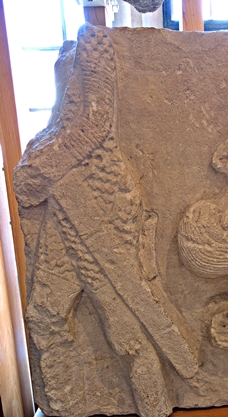
The problem being that most show the scabbard hanging at an angle that can only achieved by using an offset or a 3-point system, even when the belt does not appear to be offset in the illustration.
[ Linked Image ]
[ Linked Image ]
In the absence of surviving originals from the 11th-12th, and with art that shows contradictory qualities, its my opinion it is best to default to systems that are surviving... And originals of both the 10th C and the 13th C have angled suspensions.
As Matt pointed out, angled suspensions exist throughout to the beginning of the 11th C atleast. I find it extremely hard to believe that they would disappear for a two centuries than reappear... A much easier explanation is that the art should not be taken as absolute here.
One thing worth considering, and something I don't feel most American medievalists seem to understand is how small most of these miniatures are. They are often larger on your computer screen than they are in real life. That needs to be taken into consideration when trying to use them for detail work.
[ Linked Image ]
[ Linked Image ]
In the absence of surviving originals from the 11th-12th, and with art that shows contradictory qualities, its my opinion it is best to default to systems that are surviving... And originals of both the 10th C and the 13th C have angled suspensions.
As Matt pointed out, angled suspensions exist throughout to the beginning of the 11th C atleast. I find it extremely hard to believe that they would disappear for a two centuries than reappear... A much easier explanation is that the art should not be taken as absolute here.
One thing worth considering, and something I don't feel most American medievalists seem to understand is how small most of these miniatures are. They are often larger on your computer screen than they are in real life. That needs to be taken into consideration when trying to use them for detail work.
Last edited by Robin Smith on Thu 13 Feb, 2014 3:14 pm; edited 2 times in total
It is also worth noting that in my own research I have found that from 1350-1400 the vertical suspension method made a brief comeback as the predominant method. Many 14th c re-enactors are likely familiar with the dreaded "glued to the hip" swords that are so difficult to interpret. While some offset suspension exists during these couple of decades they are in the minority.
| Robin Smith wrote: |
| A much easier explanation is that the art should not be taken as absolute here. |
I agree that this may be an issue in certain cases, and this must always be kept in consideration.
But when multiple artists depict the same thing consistently, then we have to be careful to dismiss what we are seeing as "artistic license" simply because it doesn't fit into preconceived notions of what we want to see.
When you consider 12th C images, the same vertical suspension is shown, over and over, without offset belts or additional straps ever being shown. That is a fact that you can check yourself, and we're doing ourselves a disservice by ignoring it
Matt, about your Sutton Hoo suspension... During my research I came to the conclusion that, in order to properly interpret and understand medieval suspensions, you must understand Viking suspensions. And to understand Viking suspensions you must understand... etc., etc. There is a lot to be said about understanding how weapons were suspended all the way back to the Bronze Age. I will never have that knowledge, and so my 21st C interpretations of medieval art and effigies will always be skewed.
On a more positive note, we have hard data that the offset belt was in existence as early as the first quarter of the 13th Century, but no hard evidence of anything sooner.
Some mostly early-13th century examples where the main belt may be level, but a second strap is added, as mentioned by Matthew, or the back belt is split, which may cause the canting mentioned by Robin.
 Attachment: 55.6 KB
Attachment: 55.6 KB
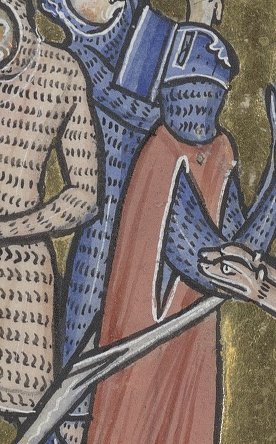
BNF Arsenal 1186 fo.19v, c.1225, France
 Attachment: 33.53 KB
Attachment: 33.53 KB
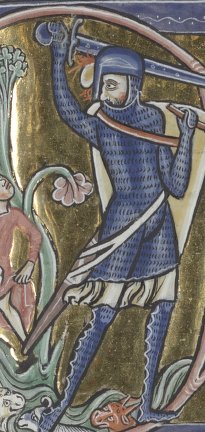
BNF Arsenal 1186 fo.77r, c.1225, France
 Attachment: 149.96 KB
Attachment: 149.96 KB
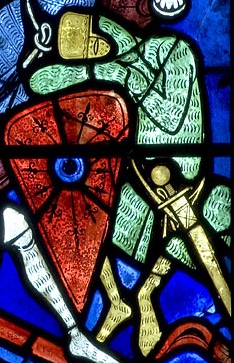
Charlemagne Windows, Chartre Cathedral, 1215-1225
 Attachment: 145.05 KB
Attachment: 145.05 KB
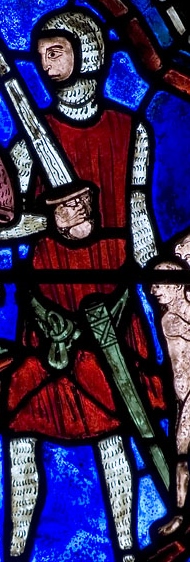
St. Sylvester Windows, Chartre Cathedral, 1215-1225
 Attachment: 106.84 KB
Attachment: 106.84 KB
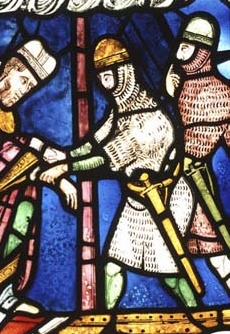
Becket Windows, Trinity Chapel, Canterbury Cathedral, 1184-1220

BNF Arsenal 1186 fo.19v, c.1225, France

BNF Arsenal 1186 fo.77r, c.1225, France

Charlemagne Windows, Chartre Cathedral, 1215-1225

St. Sylvester Windows, Chartre Cathedral, 1215-1225

Becket Windows, Trinity Chapel, Canterbury Cathedral, 1184-1220
I have seen that strap before and I didn't know what to make of it. Thanks, that's was makes this forum so great, shared knowledge and ideas.
Page 1 of 1
You cannot post new topics in this forumYou cannot reply to topics in this forum
You cannot edit your posts in this forum
You cannot delete your posts in this forum
You cannot vote in polls in this forum
You cannot attach files in this forum
You can download files in this forum
All contents © Copyright 2003-2006 myArmoury.com — All rights reserved
Discussion forums powered by phpBB © The phpBB Group
Switch to the Full-featured Version of the forum
Discussion forums powered by phpBB © The phpBB Group
Switch to the Full-featured Version of the forum